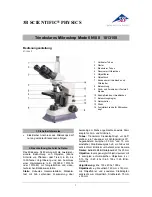
7
eyes, then carefully and slowly slide the front plate of the binocular
head inwards or outwards until your eyes can see a single bright spot.
Read the I.D. gauge, and then rotate the diopter adjusting ring to set
it at the same number as the I.D. setting. Please note that binocular
heads are aligned at “62” at the factory, as it is the standard I.D. for
most people.
5. For additional optical correction of the binocular head, use the left
eye diopter adjustment to correct the differences between the
user’s eyes. Close your left eye and focus with your right eye only.
Now switch eyes. Using your left eye (close your right eye), adjust
the diopter ring until a clear image is seen. The binocular head is
now set for you to observe the specimen.
6. While viewing through the eyepiece, rotate the coarse focus knob
slowly and carefully to raise the stage and bring the specimen into
focus. The specimen may require some centering to the field of view
at this time. Now by using the fine focusing knob, slowly and
carefully refine the focus to clearly observe the fine details of the
specimen. Now you can turn the nosepiece to the higher
magnification objectives. The objectives are parfocalized so that
once the 4x objective is focused, only a slight turn of the fine focus
is required in changing to higher power objectives.
7. Please note that smaller apertures of the iris diaphragm increase
contrast in the image while large apertures decrease the contrast.
(The iris diaphragm is not intended for controlling the brightness of
the illumination). A good procedure to follow in selecting the proper
opening is to start with the largest and reduce it until the fine detail
of the specimen is in exact focus. Using an inappropriate aperture
results in a “washing out” of the image. Care must be exercised not
to reduce the aperture too much to gain high contrast, as then the
fine structure in the image of the specimen will be destroyed.
Reducing the aperture does increase contrast and depth of focus, but
it also reduces resolution and causes diffraction. The aperture for
the 10X objective will not be the same as for the 40XRD objective,
since the angle of the required light is determined by the numerical
aperture (N.A.) of the objective, the proper aperture of the iris
diaphragm must be selected. This can be easily achieved after
minimal experience with the microscope.

































